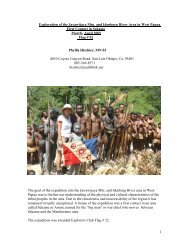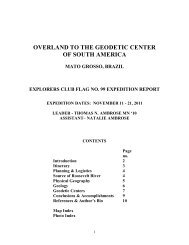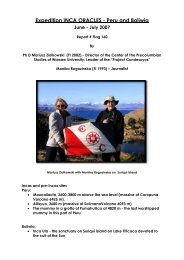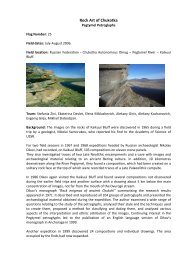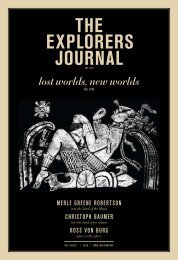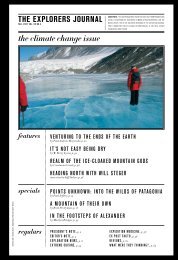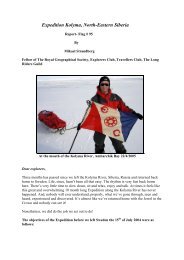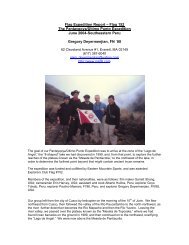the explorers journal the global adventure issue - The Explorers Club
the explorers journal the global adventure issue - The Explorers Club
the explorers journal the global adventure issue - The Explorers Club
- No tags were found...
You also want an ePaper? Increase the reach of your titles
YUMPU automatically turns print PDFs into web optimized ePapers that Google loves.
a pioneering journey: Sir wally herbert in his own wordsFour men, four teams of dogsIn this extract from <strong>The</strong> Polar World, Sir Wally described<strong>the</strong> tensions on <strong>the</strong> eve of setting out on <strong>the</strong> first surfacecrossing of <strong>the</strong> Arctic Ocean.On 20th February l968: “I signalled <strong>the</strong> pilot of <strong>the</strong> Dakotawith a nod. Our mission was to find a way onto <strong>the</strong> driftingpack ice, and our position at that time was about 80 miles[129 km] of ENE of Barrow. He eased <strong>the</strong> plane into a turnand took one last look to <strong>the</strong> north. <strong>The</strong> vast expanse ofdrifting ice was awesome—limitless. To <strong>the</strong> south, weak raysof sunlight pierced <strong>the</strong> clouds and scattered <strong>the</strong> ice withpatches of light. Cracks and open leads caught <strong>the</strong> sun likemolten silver and darted around on <strong>the</strong> surface of <strong>the</strong> packbefore turning into jet black scars that marked <strong>the</strong> blue-greyskin of <strong>the</strong> frozen sea. It was a moment of profound relief—<strong>the</strong> moment of decision. Tomorrow, four men and four teamsof dogs would set out on a journey from which <strong>the</strong>re couldbe no turning back.Our proposed journey along <strong>the</strong> longest axis of <strong>the</strong> ArcticOcean would be a pioneer journey—a horizontal Everest thatwould mark each one of us for life. Our beds, most nights,would be on ice no more than two meters thick (and oftenvery much thinner); ice which might at any time split orstart to pressure. <strong>The</strong>re would not be a day during <strong>the</strong> next16 months when <strong>the</strong> floes over which we were travelling,or sleeping off our fatigue, would not be drifting with <strong>the</strong>currents or driven by <strong>the</strong> winds. <strong>The</strong>re would be no end to<strong>the</strong> movement; no rest, no landfall, no sense of achievement,no peace of mind, until we reached Spitsbergen. Most importantly:<strong>the</strong>re was no possibility whatsoever of rescue.By midnight on <strong>the</strong> eve of our departure <strong>the</strong> pace of preparationhad slackened, and on that day I received a parcel fromhome containing <strong>the</strong> Union Jack and a note from my fa<strong>the</strong>r,which simply read: ‘You forgot your flag—good luck.’ I was sotouched by this correction that I took it on <strong>the</strong> journey. Thatlast night at Barrow I remember very well—it felt like <strong>the</strong> eveof a battle—still, clear, cold, silent, with no one sleeping; anatmosphere heavy with private thoughts. I felt as though I wasin a trench in <strong>the</strong> First World War along with <strong>the</strong> o<strong>the</strong>rs—wefixed our bayonets and just waited for <strong>the</strong> first weak light ofdawn and for <strong>the</strong> young lieutenant to blow his whistle, whereupon,almost numb, we would all scramble out to face our fate.I was physically sick with fear, and <strong>the</strong> weight of <strong>the</strong> trust thatmy three companions had in me. Which of <strong>the</strong>se two was <strong>the</strong>greater, I still do not know—even to this day.I unlatched <strong>the</strong> huge doors of <strong>the</strong> warehouse and spread<strong>the</strong>m open. <strong>The</strong> night was almost over. It was calm, clear,and very cold. <strong>The</strong> sledge moved over <strong>the</strong> floor on rollers,bit <strong>the</strong> snow, and slid forward, out into a deserted streetsmoke-grey in seeping twilight. I left it facing north-east at<strong>the</strong> end of two rows of day-bleached lights that pointed aperspective arrow south-west down <strong>the</strong> main street. <strong>The</strong>rewas not a breath of wind to dissipate <strong>the</strong> plumes of vapourthat hung over each box-like building—<strong>the</strong> camp was still andsleeping and <strong>the</strong> only sound was of <strong>the</strong> throbbing warmthwithin each man-made shelter.”And so <strong>the</strong> scene was set at Point Barrow, Alaska, on 21stFebruary l968 for <strong>the</strong> final farewells, and <strong>the</strong> start of whatmost historians now regard as <strong>the</strong> “last of <strong>the</strong> great pioneeringjourneys made on <strong>the</strong> face of <strong>the</strong> Earth.”<strong>the</strong> <strong>explorers</strong> <strong>journal</strong>



